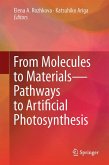The authors consider the impact of recent advances in nanotechnology on the water photoelectrolysis field, providing specific examples as well as the theories and methods necessary for achieving useful water photoelectrolysis systems. Written for users in a wide range of disciplines, including materials scientists, chemists, electrical engineers, and physicists, Light, Water, Hydrogen: The Solar Generation of Hydrogen by Water Photoelectrolysis is an up-to-date, invaluable resource for graduate students and researchers.
Dieser Download kann aus rechtlichen Gründen nur mit Rechnungsadresse in A, B, BG, CY, CZ, D, DK, EW, E, FIN, F, GR, HR, H, IRL, I, LT, L, LR, M, NL, PL, P, R, S, SLO, SK ausgeliefert werden.
"The 'Holy Grail' of artificial photosynthesis, particularly for hydrogen production, is often traced ... . This book deals with this field, largely from the point-of-view of solid-state synthesis and engineering. ... The book is useful for getting brief descriptions of the huge literature on oxide semiconductors prepared in different ways and their behavior. ... if oxide materials, and especially TiO2 nanostructures, are of major interest, this book will be useful in traversing the massive literature in this field." (Allen J. Bard, Journal of the American Chemical Society, Vol. 130 (26), 2008)
"Grimes and colleagues (all, Pennsylvania State Univ.) have done a marvelous, meticulous job of collecting the latest developments in hydrogen evolution by nontraditional means to prepare the reader to understand and appreciate the importance of semiconductor photoelectrolysis in the energy future. ... The logically developed chapters are copiously referenced (more than 1,000 references listed) and liberally annotated with graphs, tables, and other illustrative diagrams. Summing Up: Highly recommended. Upper-division undergraduate through professional collections." (S. R. Walk, CHOICE, Vol. 45 (11), July, 2008)









